15 AI Stats You Need to Know in 2025

Finney Koshy
Product Owner

Share to AI
Ask AI to summarize and analyze this article. Click any AI platform below to open with a pre-filled prompt.
In 2025, artificial intelligence systems are business-critical assets. In the United States alone, the AI market size is expected to go from $173.56 billion by the end of 2025 to $851.46 billion by 2034. This exponential growth is fueled by AI technologies like computer vision, speech recognition, and deep learning, each poised to revolutionize the vast majority of industries.
At Aloa, we track every major breakthrough in AI so we can recommend the right solution for your needs. From healthcare AI tools to brick-and-mortar solutions, we help businesses formulate effective implementation strategies that position artificial intelligence tech for maximum long-term success.
In this blog, we'll share the latest AI stats to give you a comprehensive overview of how AI has grown in recent years, including the newest stats on:
- AI market growth
- AI adoption rates
- Common implementation challenges
Whether you're evaluating AI investments, benchmarking against competitors, or planning your tech roadmap, these statistics from authoritative sources such as Stanford HAI, McKinsey, and Gartner can provide the evidence you need.
Understanding AI Stats
AI stats are the key to navigating your investment in AI. They allow you to make data-informed decisions and pursue genuine opportunities for business growth. Performance metrics and failure patterns are the most objective evidence of AI’s real-world impact.
Empowered by the latest artificial intelligence stats, you can benchmark your organization's AI maturity against industry standards. You can justify budget allocations with concrete ROI projections and anticipate skill requirements based on market demand patterns.
AI Market Growth
After its pioneering adopters proved its capabilities, businesses quickly got to work implementing every form of AI into their workflows. The result is that AI has now become so widespread that not using it puts you at an instant disadvantage. Here are the two clearest indicators that the AI arms race is only going to get more intense in the coming decades:
1. Global AI Market Hits $294 Billion in 2025
The worldwide artificial intelligence market has entered explosive growth territory, with Fortune Business Insights projecting the market will reach $294.16 billion by the end of 2025, and $1,771.62 billion by 2032.
This expansion is driven by enterprise adoption across all sectors, with 100% of industries now embracing AI, according to PWC's June 2025 analysis.
2. AI Startups Raise $107 Billion Worldwide
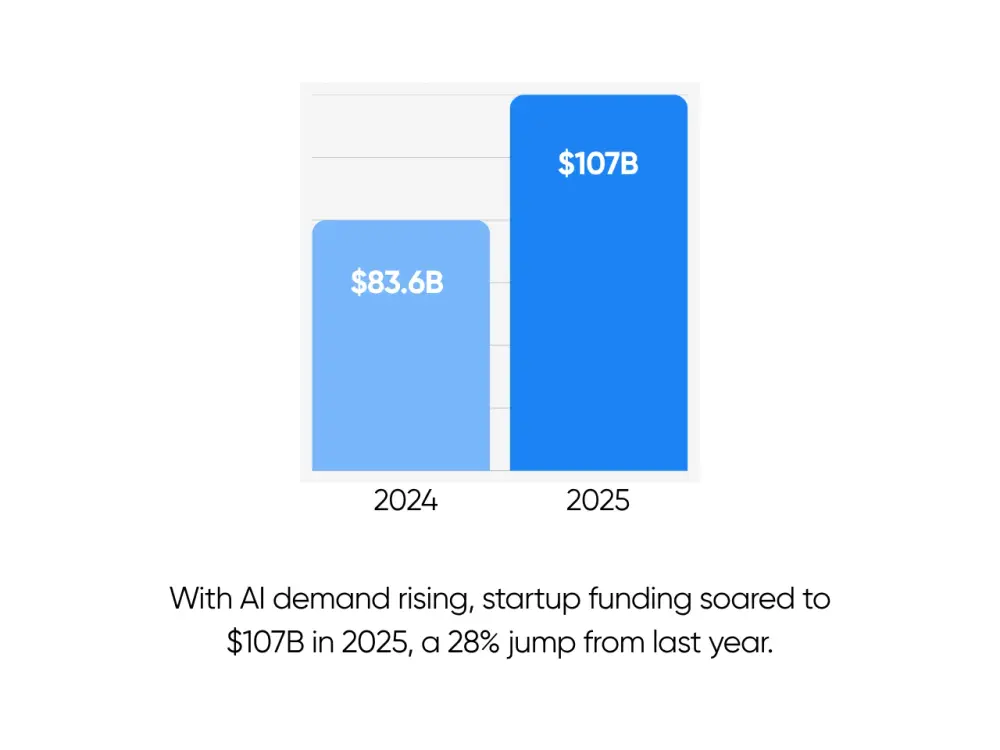
Demand for AI services surges as more and more companies prove the technology’s potential. To fill this need, AI startups are emerging at an unprecedented rate. Founders Forum Group reports that $107 billion was deployed globally into AI startups in 2025, marking a 28% year-over-year increase.
AI Adoption Rates
From digital personal assistants to marketing automation, AI use is dominating daily life, and it’s only expected to become more commonplace from here. Here are some of the latest AI usage statistics.
3. 89% of Enterprises Actively Advancing AI Initiatives
The 2025 Key Issues Study reveals that 89% of enterprise-level organizations (those with over 1,000 employees) are actively advancing their generative AI initiatives as of August 2025.
Overall adoption has accelerated dramatically, from 33% in 2023 to 71% in mid-2024. In 2025, 90% are currently exploring AI adoption opportunities, with 78% having successfully done so. Some studies, like PWC’s June 2025 analysis, even suggest that the rate of adoption is already at 100%. However, enterprises without a formal AI strategy report only 37% success in AI adoption.
Deloitte forecasts that 25% of companies using Gen AI will deploy intelligent agents in 2025, with that number expected to double to 50% by 2027.
4. 92% of Businesses Plan to Boost AI Investments Through 2027
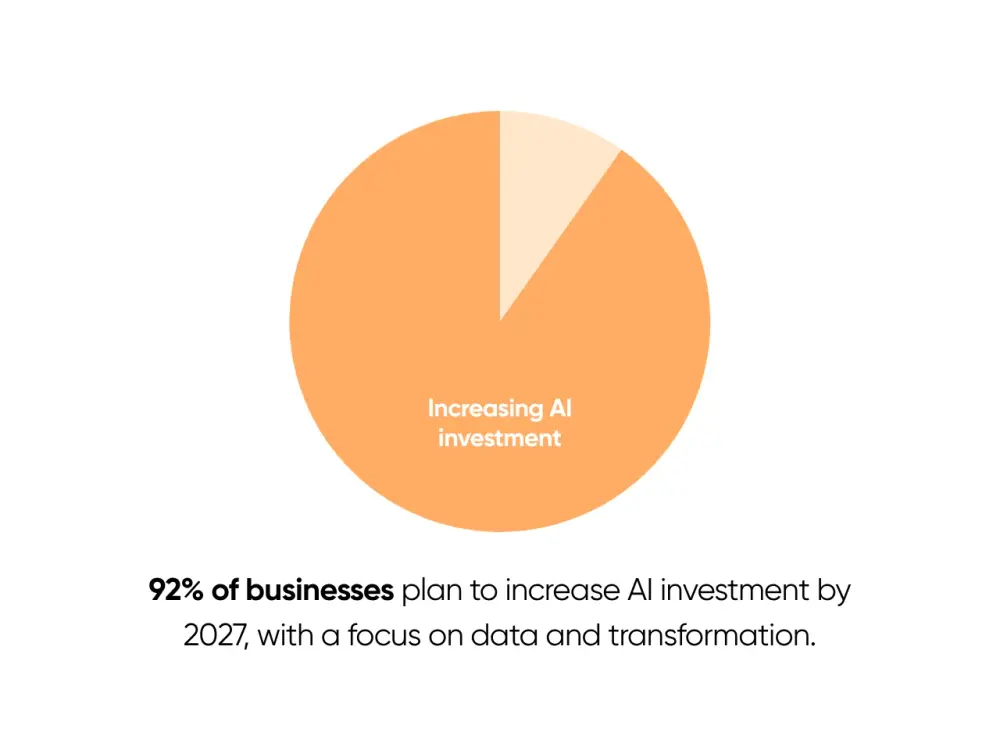
Despite widespread adoption, implementation maturity remains low. To bring their AI capabilities to peak performance, 92% of businesses are planning to increase their investments between 2025 and 2027, with 90% planning to boost investments especially in data readiness and organizational transformation.
Companies are also doubling down on infrastructure investments to better support AI software. A Bloomberg Intelligence analysis shows eight hyperscale companies (including Microsoft, Amazon, and Meta) are investing $371 billion in 2025 specifically on data centers and computing infrastructure to support AI. This is a 44% increase from the prior year.
5. Insurance AI Adoption Jumps From 29% to 48% in One Year
Insurance companies are a remarkable example of AI adoption, jumping from 29% Gen AI adoption in 2024 to 48% in 2025. Benefits reported include improved staff efficiency (61%), enhanced customer service (48%), and cost savings (56%).
Runner-up industries include telecommunications leading at 34%, followed by pharmaceuticals at 30% and banking & finance at 29%.
AI Technology Advancements
The continued dominance of AI tech is fueled by the unrelenting advance of its technological capabilities. Improved reasoning and human assistance capabilities are making AI integration easier than ever, even in sectors that were initially reluctant to engage with the tech.
6. AI Reasoning Models Achieve PhD-Level Performance
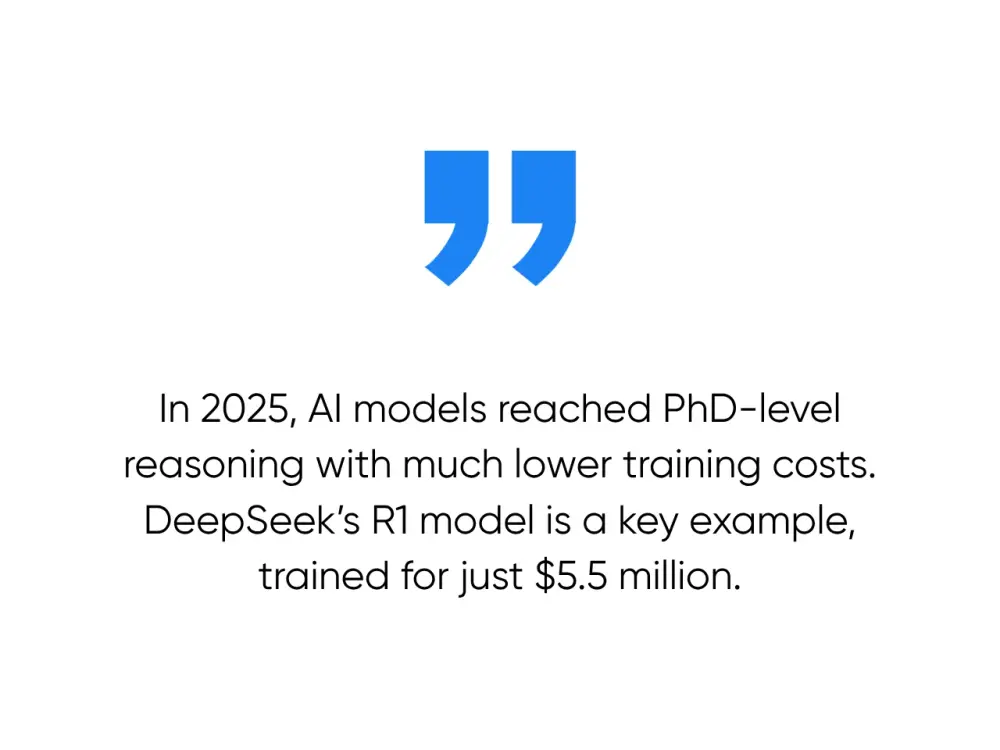
In 2025, AI reasoning models broke new ground by demonstrating PhD-level cognitive abilities across multiple domains. DeepSeek's R1 model, launched in January 2025, is one such example. These models can reason at the level of PhD students, with dramatically reduced computational requirements at only $5.5 million to train compared to hundreds of millions for similar models.
7. Half of US Households and Classrooms Using AI
PWC's June 2025 analysis found that 50% of teachers now use AI for lesson planning and research, while 42-45% of U.S. households own at least one AI-powered smart home device, integrating AI into daily routines.
8. One-Third of Enterprise Software to Have Agentic AI
Gartner reports that by 2028, nearly one-third (33%) of enterprise software applications will have built-in agentic capabilities. These artificial intelligence technologies will enable 15% of day-to-day work decisions to be made autonomously, allowing AI systems to receive instructions, create plans, use tooling to complete tasks, and produce dynamic outputs without requiring explicit inputs. In 2024, only 1% of enterprise software was equipped with agentic AI.
Economic Impact of AI
The main driver for AI’s widespread adoption is its effect on a company’s bottom line. Across economies, AI is proving its worth with a net increase to both organizational and national revenue.
9. AI Spending to Make $4.60 Per Dollar Invested
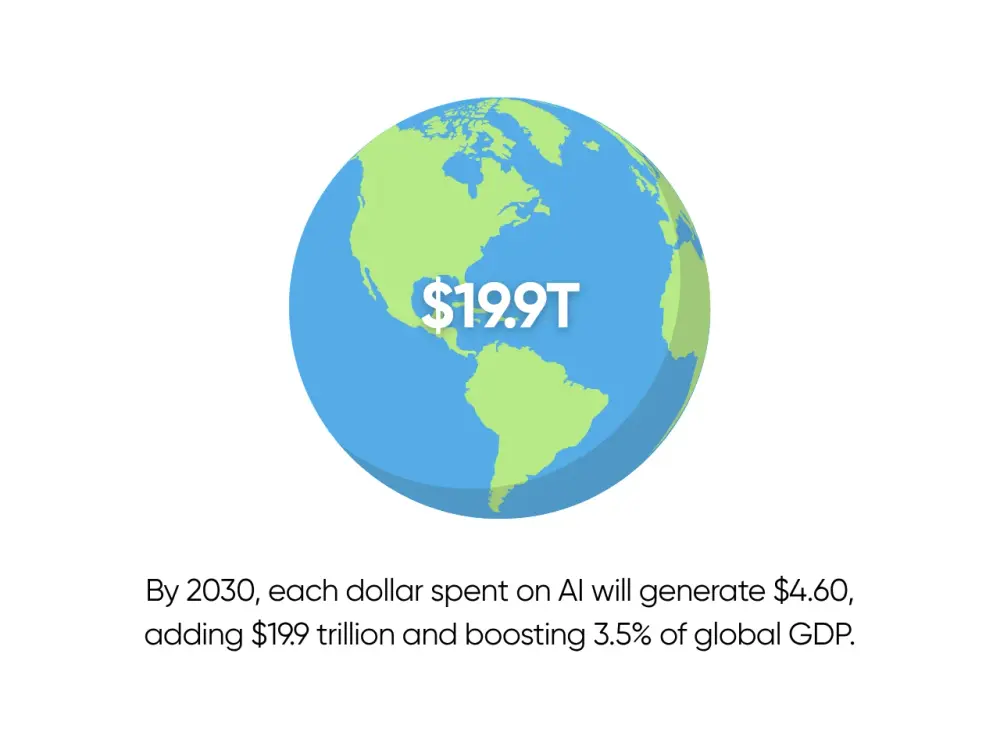
IDC's economic impact analysis reveals that by 2030, every new dollar spent on business-related AI solutions will generate $4.60 into the global economy. The field of AI as a whole is projected to contribute $19.9 trillion cumulatively through 2030, driving 3.5% of global GDP. Stanford reports that AI costs are up to 280 times cheaper compared to the price point in late 2022, indicating that this prediction could very well be accurate.
10. AI Could Add $19.9 Trillion to Global Economy by 2030
PWC's April 2025 research suggests AI could boost global economic output by up to 15 percentage points over the next decade, effectively adding one percentage point to annual growth rates. PWC estimates AI could contribute up to $15.7 trillion to the global economy by 2030, with $6.6 trillion from increased productivity and $9.1 trillion from consumption-side effects.
11. Early Adopters Report 14% Higher Retention and 48% Customer Satisfaction
IBM Institute for Business Value found that early adopters using Gen AI significantly in customer-facing systems report a 14% higher retention rate and a 48% higher Net Promoter Score compared to insurers not using it. Net Promoter Score is a customer experience metric that measures customer loyalty by asking how likely customers are to recommend a company, product, or service to a friend or colleague on a scale from 0 to 10.
12. AI Workers Earn 56% More, Wages Rise 2x Faster
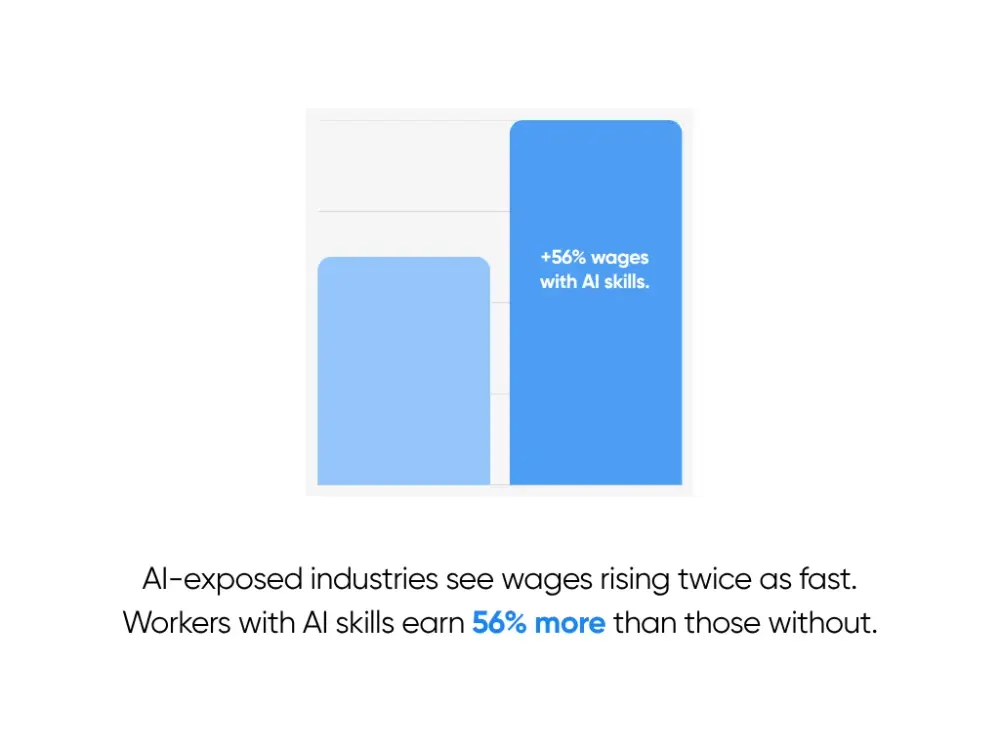
PWC's June 2025 AI Jobs Barometer reveals wages are rising twice as fast in the most AI-exposed industries compared to less exposed sectors. Workers who upskill in AI enjoy a 56% wage premium versus those who don't.
AI Implementation Challenges
AI initiatives aren’t without their hiccups. Here are some of the most critical AI implementation challenges that businesses struggle with.
13. 42% of Businesses Now Abandon AI Projects
S&P Global data (March 2025) shows the share of businesses scrapping most of their AI initiatives increased dramatically to 42% this year, up from 17% in 2024. NTT DATA reports that between 70-85% of current AI initiatives fail to meet expected outcomes.
RAND Corporation research confirms over 80% of AI projects fail. This is twice the rate of non-AI IT projects. The main reasons cited include a misunderstanding of what the technology is meant to solve and a bias towards acquiring the latest technology instead of addressing real problems.
14. 54% of Insurers Say Implementation is the Main Barrier to Adoption
EY's insurance survey found 54% of insurance decision-makers cite cost of implementation as the main challenge to Gen AI adoption, with 46% indicating high energy consumption as another key barrier. Additionally, integration with legacy IT systems remains a predominant challenge for insurers exploring Gen AI initiatives.
SAS research identified that uncertainty about expected ROI is a top barrier to establishing dedicated Gen AI teams, particularly given the difficulty in estimating Gen AI's potential impact on key metrics like loss ratios.
15. Only 29% of Insurance Customers Trust AI-Generated Advice
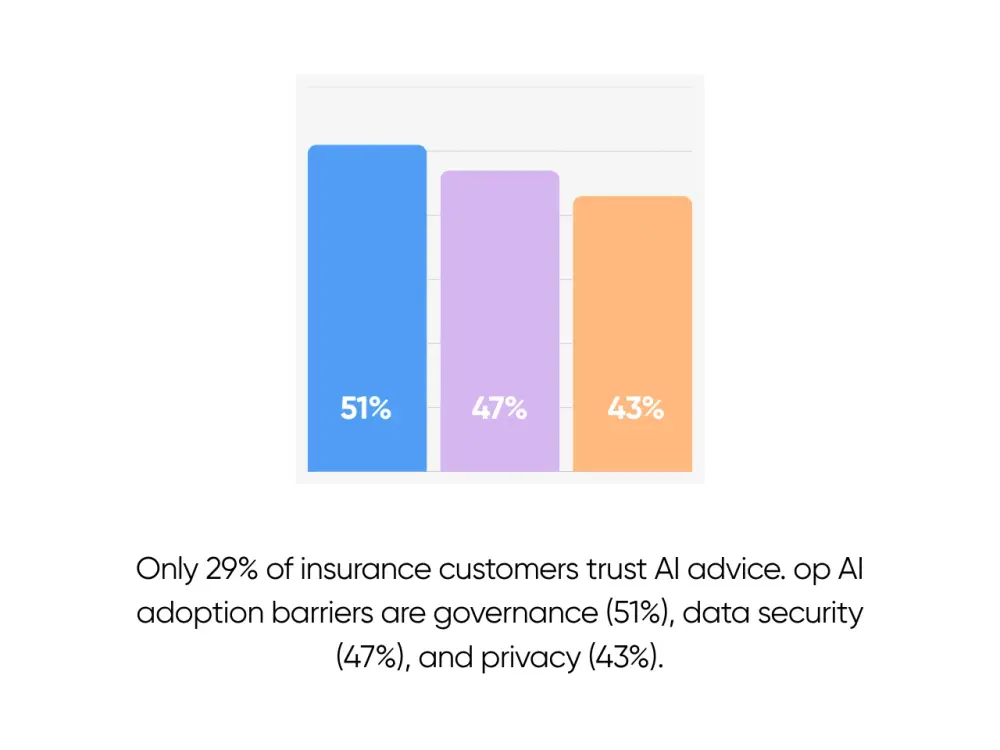
IBM Institute for Business Value surveyed 4,700 insurance customers across nine countries and found only 29% are comfortable with gen AI virtual agents providing service, with just 26% trusting the reliability and accuracy of AI-generated advice. This trust gap is indicative of a need to invest more in the human side of AI.
Atomic Work's State of AI in IT 2025 found governance and compliance (51%) as the foremost barrier to AI adoption across industries, followed by customer data security (47%) and employee data privacy (43%).
Conclusion
When ChatGPT kickstarted the AI revolution in 2022, the world was forever changed. With AI now a business reality across 100% of industries, AI adoption is as inevitable as digitization was. Between benefits like almost 5 to 1 ROI and AI agents with true reasoning capabilities, the question is no longer whether to adopt AI, but how quickly and effectively you can implement it to stay competitive.
But as these AI stats show, although AI is 280 times more cost-effective now, success still hinges on solving the same challenges that were present in the early days. This is why, at Aloa, we always incorporate maximizing data quality, aligning with real-world challenges, and fostering customer trust into our implementation plans.
At Aloa, our tried and tested custom AI development process ensures that your implementation and trust strategies are built from the ground up to integrate with your existing systems and procedures. 70-80% of AI projects fail, but Aloa can help you beat the odds. Reach out to us today!